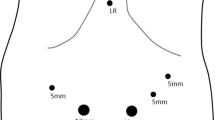Abstract
Background
Two of the most common foregut operations are laparoscopic Heller myotomy and laparoscopic Nissen fundoplication. Robotic assistance, compared to standard laparoscopic approach, may potentially grant surgeons advantages such as enhanced visualization and dexterity. This study compares patient outcomes for Heller myotomy (HM) and Nissen fundoplication (NF) when performed laparoscopically versus robotically.
Methods
A retrospective review of patients at a single institution who underwent laparoscopic or robotic-assisted HM or NF from January 2019 to July 2022 was conducted. 123 HM (72 laparoscopic, 51 robotic-assisted) and 92 NF (62 laparoscopic, 30 robotic-assisted) were performed by three surgeons. Outcomes investigated were operative time, hospital length of stay, pre- and post-operative imaging, resolution of symptoms at 30 days, resolution of symptoms at 90 days, and complications.
Results
In the HM cohorts, the average operative time was longer in the robotic cohort (127 min robotic versus 108 min laparoscopic, p < 0.01). However, overall complication rates (p < 0.05) were lower, and hospital length of stay was shorter in the robotic group (1.5 days compared to 2.7 days, p < 0.001). In the NF cohorts, there was no significant difference in operative time. However, hospital length of stay was shorter in the robotic group (1.54 days compared to 2.7 days, p < 0.001) with otherwise similar outcomes. There was no difference in the rate of post-operative resolution of symptoms or need for additional interventions in either HM or NF.
Conclusion
Robotic-assisted HM and NF are associated with shorter hospital stays compared to their respective laparoscopic approaches. Robotic-assisted HM also has a lower rate of complications. Our findings suggest that robotic assistance may be beneficial for shortening hospital length of stay and decreasing complications for certain surgeries specific to Foregut surgery.

Similar content being viewed by others
References
Galvani C, Gorodner MV, Moser F, Baptista M, Donahue P, Horgan S (2006) Laparoscopic Heller myotomy for achalasia facilitated by robotic assistance. Surg Endosc 20:1105–1112
Galvani CA, Gallo AS, Dylewski MR (2011) Robotic-assisted Heller myotomy for esophageal achalasia: feasibility, technique, and short-term outcomes. J Robot Surg 5:163–166
Markar SR, Karthikesalingam AP, Hagen ME, Talamini M, Horgan S, Wagner OJ (2010) Robotic vs. laparoscopic Nissen fundoplication for gastro-oesophageal reflux disease: systematic review and meta-analysis. Int J Med Robot 6:125–131
Rodriguez-Sanjuan JC, Gomez-Ruiz M, Trugeda-Carrera S, Manuel-Palazuelos C, Lopez-Useros A, Gomez-Fleitas M (2016) Laparoscopic and robot-assisted laparoscopic digestive surgery: present and future directions. World J Gastroenterol 22:1975–2004
Xie J, Vatsan MS, Gangemi A (2021) Laparoscopic versus robotic-assisted Heller myotomy for the treatment of achalasia: a systematic review with meta-analysis. Int J Med Robot 17:e2253
Yao G, Liu K, Fan Y (2014) Robotic Nissen fundoplication for gastroesophageal reflux disease: a meta-analysis of prospective randomized controlled trials. Surg Today 44:1415–1423
Tartaglia N, Pavone G, Di Lascia A, Vovola F, Maddalena F, Fersini A, Pacilli M, Ambrosi A (2020) Robotic voluminous paraesophageal hernia repair: a case report and review of the literature. J Med Case Rep 14:25
Ali AB, Khan NA, Nguyen DT, Chihara R, Chan EY, Graviss EA, Dunkin BJ, Kim MP (2020) Robotic and per-oral endoscopic myotomy have fewer technical complications compared to laparoscopic Heller myotomy. Surg Endosc 34:3191–3196
Damani T, Ballantyne G (2020) Robotic foregut surgery. Surg Clin North Am 100:249–264
Milone M, Manigrasso M, Vertaldi S, Velotti N, Aprea G, Maione F, Gennarelli N, De Simone G, De Conno B, Pesce M, Sarnelli G, De Palma GD (2019) Robotic versus laparoscopic approach to treat symptomatic achalasia: systematic review with meta-analysis. Dis Esophagus 32:1–8
Cadiere GB, Himpens J, Vertruyen M, Bruyns J, Germay O, Leman G, Izizaw R (2001) Evaluation of telesurgical (robotic) NISSEN fundoplication. Surg Endosc 15:918–923
Gerull WD, Cho D, Arefanian S, Kushner BS, Awad MM (2021) Favorable peri-operative outcomes observed in paraesophageal hernia repair with robotic approach. Surg Endosc 35:3085–3089
O’Connor SC, Mallard M, Desai SS, Couto F, Gottlieb M, Ewing A, Cobb WS, Carbonell AM, Warren JA (2020) Robotic versus laparoscopic approach to hiatal hernia repair: results after 7 years of robotic experience. Am Surg 86:1083–1087
Soliman BG, Nguyen DT, Chan EY, Chihara RK, Meisenbach LM, Graviss EA, Kim MP (2020) Robot-assisted hiatal hernia repair demonstrates favorable short-term outcomes compared to laparoscopic hiatal hernia repair. Surg Endosc 34:2495–2502
Lang F, Huber A, Kowalewski KF, Kenngott HG, Billmann F, Billeter AT, Fischer L, Bintintan VV, Gutt CN, Muller-Stich BP, Nickel F (2022) Randomized controlled trial of robotic-assisted versus conventional laparoscopic fundoplication: 12 years follow-up. Surg Endosc 36:5627–5634
Author information
Authors and Affiliations
Corresponding author
Ethics declarations
Disclosures
Christopher DuCoin is a consultant for Medtronic and provides educational services for Intuitive and Boston Sci. Langfeier Liu, Nicholas Lewis, Rahul Mhaskar, and Joseph Sujka have no conflicts of interest or financial ties to disclose.
Additional information
Publisher's Note
Springer Nature remains neutral with regard to jurisdictional claims in published maps and institutional affiliations.
Rights and permissions
Springer Nature or its licensor (e.g. a society or other partner) holds exclusive rights to this article under a publishing agreement with the author(s) or other rightsholder(s); author self-archiving of the accepted manuscript version of this article is solely governed by the terms of such publishing agreement and applicable law.
About this article
Cite this article
Liu, L., Lewis, N., Mhaskar, R. et al. Robotic-assisted foregut surgery is associated with lower rates of complication and shorter post-operative length of stay. Surg Endosc 37, 2800–2805 (2023). https://doi.org/10.1007/s00464-022-09814-6
Received:
Accepted:
Published:
Issue Date:
DOI: https://doi.org/10.1007/s00464-022-09814-6



